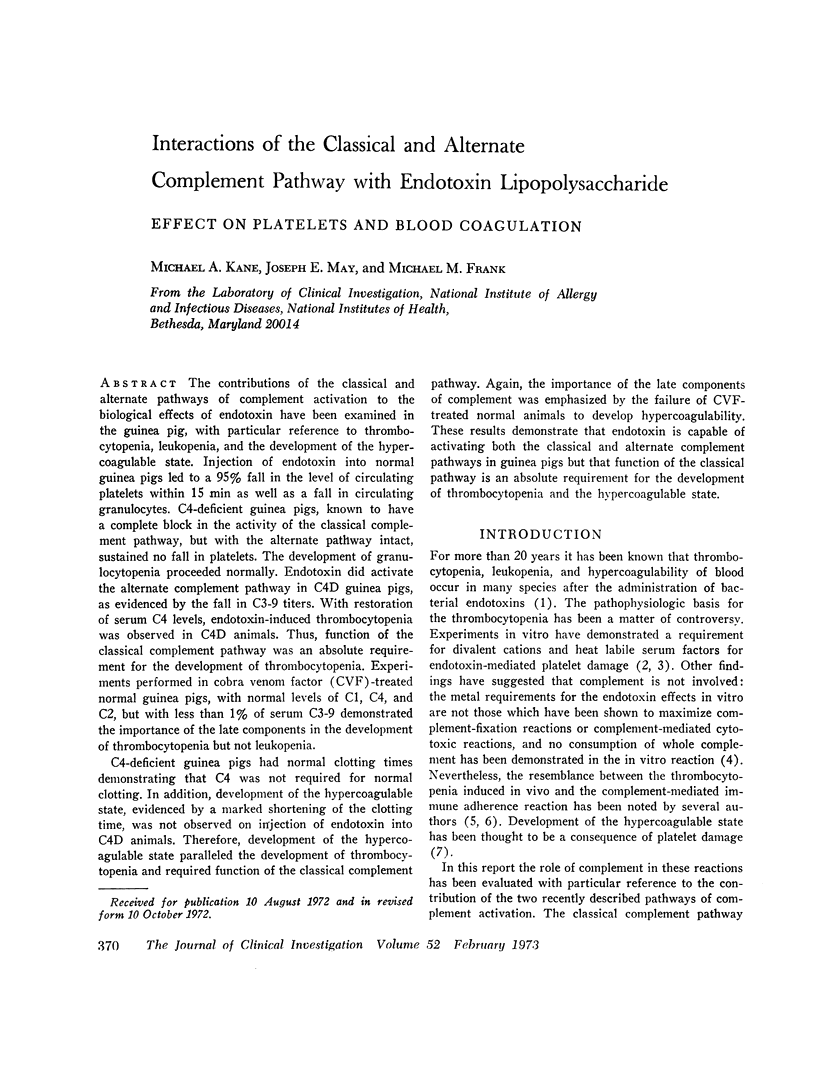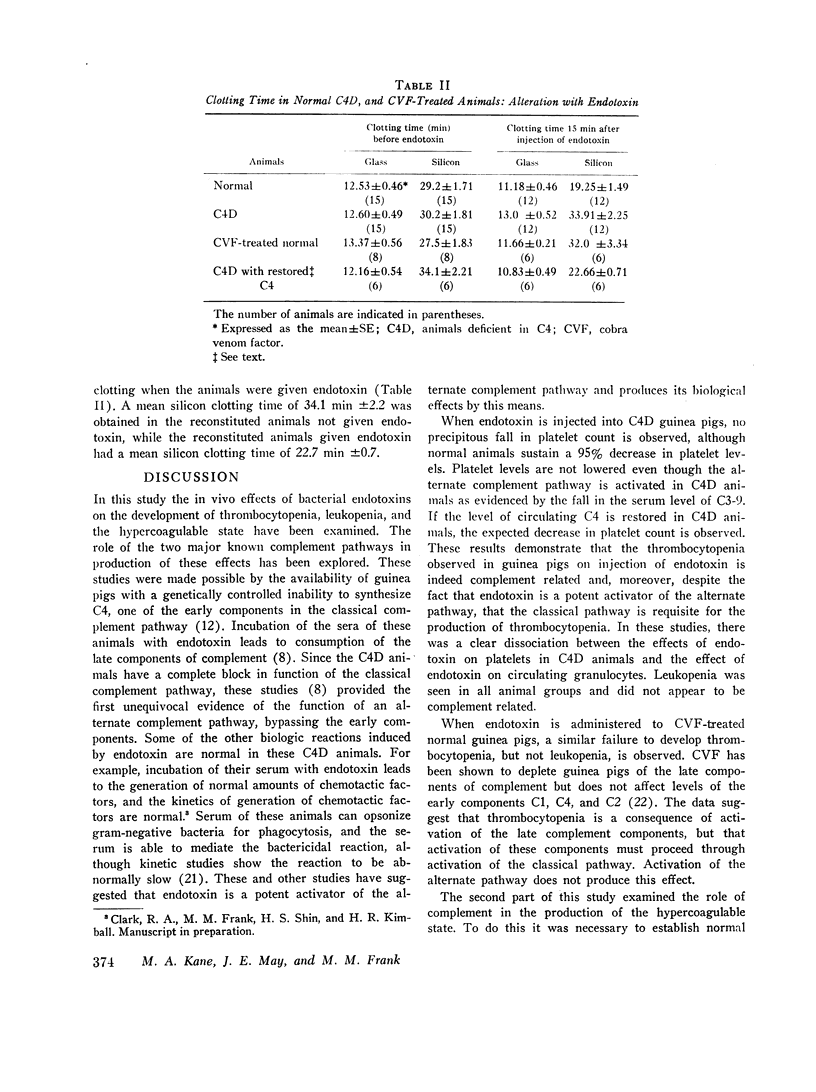Abstract
The contributions of the classical and alternate pathways of complement activation to the biological effects of endotoxin have been examined in the guinea pig, with particular reference to thrombocytopenia, leukopenia, and the development of the hypercoagulable state. Injection of endotoxin into normal guinea pigs led to a 95% fall in the level of circulating platelets within 15 min as well as a fall in circulating granulocytes. C4-deficient guinea pigs, known to have a complete block in the activity of the classical complement pathway, but with the alternate pathway intact, sustained no fall in platelets. The development of granulocytopenia proceeded normally. Endotoxin did activate the alternate complement pathway in C4D guinea pigs, as evidenced by the fall in C3-9 titers. With restoration of serum C4 levels, endotoxin-induced thrombocytopenia was observed in C4D animals. Thus, function of the classical complement pathway was an absolute requirement for the development of thrombocytopenia. Experiments performed in cobra venom factor (CVF)-treated normal guinea pigs, with normal levels of C1, C4, and C2, but with less than 1% of serum C3-9 demonstrated the importance of the late components in the development of thrombocytopenia but not leukopenia.
C4-deficient guinea pigs had normal clotting times demonstrating that C4 was not required for normal clotting. In addition, development of the hypercoagulable state, evidenced by a marked shortening of the clotting time, was not observed on injection of endotoxin into C4D animals. Therefore, development of the hypercoagulable state paralleled the development of thrombocytopenia and required function of the classical complement pathway. Again, the importance of the late components of complement was emphasized by the failure of CVF-treated normal animals to develop hypercoagulability. These results demonstrate that endotoxin is capable of activating both the classical and alternate complement pathways in guinea pigs but that function of the classical pathway is an absolute requirement for the development of thrombocytopenia and the hypercoagulable state.
Full text
PDF






Selected References
These references are in PubMed. This may not be the complete list of references from this article.
- Bull B. S., Schneiderman M. A., Brecher G. Platelet counts with the Coulter counter. Am J Clin Pathol. 1965 Dec;44(6):678–688. doi: 10.1093/ajcp/44.6.678. [DOI] [PubMed] [Google Scholar]
- Corrigan J. J., Jr, Ray W. L., May N. Changes in the blood coagulation system associated with septicemia. N Engl J Med. 1968 Oct 17;279(16):851–856. doi: 10.1056/NEJM196810172791603. [DOI] [PubMed] [Google Scholar]
- DES PREZ R. M., HOROWITZ H. I., HOOK E. W. Effects of bacterial endotoxin on rabbit platelets. I. Platelet aggregation and release of platelet factors in vitro. J Exp Med. 1961 Dec 1;114:857–874. doi: 10.1084/jem.114.6.857. [DOI] [PMC free article] [PubMed] [Google Scholar]
- Des Prez R. M., Bryant R. E. Effects of bacterial endotoxin on rabbit platelets. IV. The divalent ion requirements of endotoxin-induced and immunologically induced platelet injury. J Exp Med. 1966 Nov 1;124(5):971–982. doi: 10.1084/jem.124.5.971. [DOI] [PMC free article] [PubMed] [Google Scholar]
- Des Prez R. M. The effects of bacterial endotoxin on rabbit platelets. V. Heat labile plasma factor requirements of endotoxin-induced platelet injury. J Immunol. 1967 Nov;99(5):966–973. [PubMed] [Google Scholar]
- Frank M. M., May J., Gaither T., Ellman L. In vitro studies of complement function in sera of C4-deficient guinea pigs. J Exp Med. 1971 Jul 1;134(1):176–187. doi: 10.1084/jem.134.1.176. [DOI] [PMC free article] [PubMed] [Google Scholar]
- Gewurz H., Shin H. S., Mergenhagen S. E. Interactions of the complement system with endotoxic lipopolysaccharide: consumption of each of the six terminal complement components. J Exp Med. 1968 Nov 1;128(5):1049–1057. doi: 10.1084/jem.128.5.1049. [DOI] [PMC free article] [PubMed] [Google Scholar]
- Götze O., Müller-Eberhard H. J. The C3-activator system: an alternate pathway of complement activation. J Exp Med. 1971 Sep 1;134(3 Pt 2):90s–108s. [PubMed] [Google Scholar]
- HERRING W. B., HERION J. C., WALKER R. I., PALMER J. G. Distribution and clearance of circulating endotoxin. J Clin Invest. 1963 Jan;42:79–87. doi: 10.1172/JCI104698. [DOI] [PMC free article] [PubMed] [Google Scholar]
- MULHOLLAND J. H., WOLFF S. M., JACKSON A. L., LANDY M. QUANTITATIVE STUDIES OF FEBRILE TOLERANCE AND LEVELS OF SPECIFIC ANTIBODY EVOKED BY BACTERIAL ENDOTOXIN. J Clin Invest. 1965 Jun;44:920–928. doi: 10.1172/JCI105209. [DOI] [PMC free article] [PubMed] [Google Scholar]
- Marcus R. L., Shin H. S., Mayer M. M. An alternate complement pathway: C-3 cleaving activity, not due to C4,2a, on endotoxic lipopolysaccharide after treatment with guinea pig serum; relation to properdin. Proc Natl Acad Sci U S A. 1971 Jun;68(6):1351–1354. doi: 10.1073/pnas.68.6.1351. [DOI] [PMC free article] [PubMed] [Google Scholar]
- May J. E., Frank M. M. Complement-mediated tissue damage: contribution of the classical and alternate complement pathways in the Forssman reaction. J Immunol. 1972 Jun;108(6):1517–1525. [PubMed] [Google Scholar]
- May J. E., Green I., Frank M. M. The alternate complement pathway in cell damage: antibody-mediated cytolysis of erythrocytes and nucleated cells. J Immunol. 1972 Sep;109(3):595–601. [PubMed] [Google Scholar]
- May J. E., Kane M. A., Frank M. M. Immune adherence by the alternate complement pathway. Proc Soc Exp Biol Med. 1972 Oct;141(1):287–290. doi: 10.3181/00379727-141-36760. [DOI] [PubMed] [Google Scholar]
- McKAY D. G., SHAPIRO S. S. Alterations in the blood coagulation system induced by bacterial endotoxin. I. In vivo (generalized Shwartzman reaction). J Exp Med. 1958 Mar 1;107(3):353–367. doi: 10.1084/jem.107.3.353. [DOI] [PMC free article] [PubMed] [Google Scholar]
- PILLEMER L., SCHOENBERG M. D., BLUM L., WURZ L. Properdin system and immunity. II. Interaction of the properdin system with polysaccharides. Science. 1955 Sep 23;122(3169):545–549. doi: 10.1126/science.122.3169.545. [DOI] [PubMed] [Google Scholar]
- Phillips J. K., Snyderman R., Mergenhagen S. E. Activation of complement by endotoxin: a role for 2 globulin, C1, C4 and C2 in the consumption of terminal complement components by endotoxin-coated erythrocytes. J Immunol. 1972 Aug;109(2):334–341. [PubMed] [Google Scholar]
- RICHAR W. J., BREAKELL E. S. Evaluation of an electronic particle counter for the counting of white blood cells. Am J Clin Pathol. 1959 May;31(5):384–393. doi: 10.1093/ajcp/31.5.384. [DOI] [PubMed] [Google Scholar]
- Root R. K., Ellman L., Frank M. M. Bactericidal and opsonic properties of C4-deficient guinea pig serum. J Immunol. 1972 Sep;109(3):477–486. [PubMed] [Google Scholar]
- STETSON C. A., Jr Studies on the mechanism of the Shwartzman phenomenon; certain factors involved in the production of the local hemorrhagic necrosis. J Exp Med. 1951 May;93(5):489–504. doi: 10.1084/jem.93.5.489. [DOI] [PMC free article] [PubMed] [Google Scholar]
- Sandberg A. L., Osler A. G., Shin H. S., Oliveira B. The biologic activities of guinea pig antibodies. II. Modes of complement interaction with gamma 1 and gamma 2-immunoglobulins. J Immunol. 1970 Feb;104(2):329–334. [PubMed] [Google Scholar]
- Shin H. S., Gewurz H., Snyderman R. Reaction of a cobra venom factor with guinea pig complement and generation of an activity chemotactic for polymorphonuclear leukocytes. Proc Soc Exp Biol Med. 1969 May;131(1):203–207. doi: 10.3181/00379727-131-33840. [DOI] [PubMed] [Google Scholar]
- Spielvogel A. R. An ultrastructural study of the mechanisms of platelet-endotoxin interaction. J Exp Med. 1967 Aug 1;126(2):235–250. doi: 10.1084/jem.126.2.235. [DOI] [PMC free article] [PubMed] [Google Scholar]
- WOLFF S. M., WARD S. B., LANDY M. SEROLOGIC PROPERTIES OF BENTONITE PARTICLES COATED WITH MICROBIAL POLYSACCHARIDES. Proc Soc Exp Biol Med. 1963 Nov;114:530–536. doi: 10.3181/00379727-114-28724. [DOI] [PubMed] [Google Scholar]
- Zimmerman T. S., Arroyove C. M., Müller-Eberhard H. J. A blood coagulation abnormality in rabbits deficient in the sixth component of complement (C6) and its correction by purified C6. J Exp Med. 1971 Dec 1;134(6):1591–1600. doi: 10.1084/jem.134.6.1591. [DOI] [PMC free article] [PubMed] [Google Scholar]
- Zimmerman T. S., Müller-Eberhard H. J. Blood coagulation initiation by a complement-mediated pathway. J Exp Med. 1971 Dec 1;134(6):1601–1607. doi: 10.1084/jem.134.6.1601. [DOI] [PMC free article] [PubMed] [Google Scholar]


